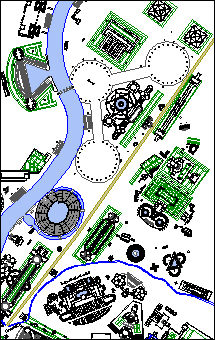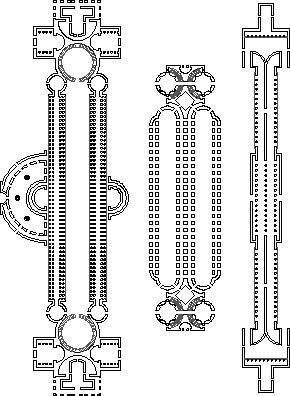Tafuri, Manfredo
1998.11.16
After an extended independent analysis of the Ichnographia Campus Martius, it becomes evident that Tafuri misreads Piranesi's large plan in most cases. Tafuri's text indicates no research of the plan beyond simply looking at it and subsequently offering a description of what Tafuri thinks he sees. (In fact, a careful reading of both Tafuri's texts and the text of Fasolo from 1956, clearly shows that Fasolo's text greatly influenced Tafuri's observations.) For example, in calling out the various axes of the Campo Marzio, Tafuri notes the axis running through Hadrian's Tomb, but he fails to recognize it's symbolic function as the Axis of Death; nor does he identify the Axis of Life that runs perpendicular to the Axis of Death. Moreover, Tafuri marginally notes the semblance of an axis within the northeast sector of the plan, yet he never mentions that Piranesi labeled this axis the Equiria, place of the annual horse races instituted by Romulus in honor of Mars.
These are just two examples which plainly demonstrate that Piranesi's plan holds significant and coherent symbolic content, however, recognition of Piranesi's "carved in stone" symbolism necessarily negates Tafuri's primary thesis that the Ichnographiam Campi Martii is utterly fragmented and devoid of "language." Ironically, had Tafuri not discounted the presence of language and instead actually translated the hundreds of Latin labels Piranesi applies throughout the plan, he would have concluded with a more accurate, if not also a more honest reading.
It is truly unfortunate that the subsequent 20th century Campo Marzio analyses of Allen, Bloomer, and Eisenman, build upon Tafuri's mistakes rather than correct them.
Porticus
1998.12.01
Even though Piranesi employs a different imaginative arrangement for each porticus delineated within the Ichnographia, he nonetheless exhibits an overall consistency within a discernible set of design patterns. Each porticus contains a profusion of colonnades. The oldest porticus are simply linear in plan, and those along major axes such as the Via Lati and the Equiria are linear in the extreme. The Porticus Horti Domitiae and the Porticus Europae incorporate circular motifs, and the two Porticus Neronianae are cruciform in plan. Finally, the porticus of Hadrian and the later emperors are very hybrid in that they incorporate any number of colonnade plan motifs, as well as contain an array of enclosed spaces.
Circulus
Ludus
Cochlearum Hirpini
Officinae Balistarium
Officinae Scorpiorum
Petronia Amnis
Porticus a S.P.Q.R. Amoenitati Dicata
Porticus Alexandri Severi
Porticus Vipsania
Templum Castorum
1998.12.01
| |
Equiria
1998.12.01
the annual horse-races held on the 27th of February and the 14th of March in the Campus Martius, in honor of Mars
|
According to Festus, it was Romulus who instituted the first horse-races in honor of Mars. These races became an annual event, and, due to their origin, are rightly considered the "proto" festival or feast of Roman tradition. According to Varro, the races took on the name of Equirria, which is derived "from the equorum cursus 'running of horses'; for on that day they currunt 'run' races in the sports on the Campus Martius." Furthermore, Ovid's Fasti lists the dates of the races as the 27th of February and the 14th of March, and, since the Roman calendar began the 1st of March, the holding of the first horse-race the day just before the new year further attests the Equirria's premire "fest" position.
The Equiria's delineation within the Ichnographia Campus Martius represents the path that the horse-races took. Although Piranesi's linear positioning of the race course maintains some veracity, this rendition of the Equiria, along with its surrounding buildings, exhibits Piranesi's own design rather than an accurate display of the ancient Roman topography within this respective region. For example, the line of the Ichnographia's Equiria coincides exactly with Rome's present-day Via Flaminia, and the Via Flaminia, in turn, is a northern extension of the Corso, which is the traditional site of the races, and derives its name from the same equorum cursus as the Equiria. Like the present Via Flaminia, Piranesi's Equiria is a northern extension of the ancient horse-race's actual place of occurrence. Furthermore, Piranesi starts his Equiria just north of the Petronia Amnis, but Piranesi moved this ancient stream to a more nothern position as well. Hence, Piranesi is obviously aware of the historical facts, yet he chose to transfer the facts to another location. Moreover, Piranesi's careful programming and designing of the buildings either side of his Equiria supports the supposition that he deliberately moved the Equiria to a more accommodating and serviceable location. Piranesi's actions in this regard are thus willful in both senses of the word -- he did not comply with historical accuracy, although he drew the Equiria with the best redesign intentions.
All the buildings Piranesi locates along the Equiria, with the exception of the private gardens high on the hills overlooking the race course, serve one of two purposes -- they are there either to accomodate the many spectators of the horse-races or to administer some military function. In both cases, therefore, the buildings are implicit contributory factors to the honor of Mars, and it is this tacit distinction of purpose that imparts Piranesi's true design intentions.
| |

The Equiria shown as the line extending from the lower left to the upper right. The Tiber meanders along the left, and the Petronia Amnis meanders along the bottom.
Catalogo reference:
Equirie « nel lib. 5, Ovid. nel lib. 1 dei Festi e Festo.» Si riferiscono nel cap. I, art. VII, e nel cap. II, art. II.
|
The three porticus along the Equiria, the Porticus a S.P.Q.R. Amoentitati Dicata, the Porticus Vipsania, and the Porticus Alexandri Severi respectively from south to north, are great linear plans with extensive colonnades opening directly onto the Equiria, and therefore it is easy to imagine how these covered galleries could hold hundreds, if not thousands, of Equiria spectators. Furthermore, the names of the three porticus themselves carry patriotic connotations. Porticus a S.P.Q.R. Amoenitati Dicata literally means a colonnade dedicated to the pleasure of the senate and people of Rome, and is thus a fitting structure for placement alongside the Equiria's starting point. The Porticus Vipsania is one of several porticus built by M. Vipsanius Agrippa, who, as son-in-law of Augustus, was greatly instrumental in the first "building boom" of the Campus Martius. It must be noted, however, that Piranesi dislocates the Porticus Vipsania, like the Equiria, from its presumable site to a more northern position. The Porticus Alexandri Severi, at the northern end of the Equiria, is named for Alexander Severus, the third century emperor who, according to Lampridius, was much beloved by the Roman troops, and, during his military campaigns, "was more concerned for the soldier's welfare than for his own." There was indeed a Porticus Alexandri Severi within the Campus Martius, but again Piranesi dislocates its position to accentuate the specific civic and military parti of his own Equiria design.
| |

left: Porticus a S.P.Q.R. Amoenitati Dicata - 1845 feet long
center: Porticus Vipsania - 1255 feet long
right: Porticus Alexandri Severi - 1821 feet long
|
The buildings along the Equiria related to the military are: the Officinae Balistarium, the Officinae Scorpiorium, the Templum Castrum, the Naumachia Domitiani, three Circulus with two Ludus, the Officinae Armorum with its attached Officinae machinarum militarium, the Templa Jovis Martis Veneris, and an Aedicula Isidis, all of which translate into a ballista factory, a scorpion factory, a temple dedicated to Castor (the guide to mariners), a stadium for the show of mock sea-fights, exercise fields, a factory for arms and military machines, and a triple temple dedicated to Jupiter, Mars, and Venus and chapel dedicated to Isis. These buildings, moreover, are interspersed with "statues of illustrious men" as well as the sepulchers of many distinguished military figures from Roman history. This concentration of military functions essentially constitutes a design for ancient Rome's main military headquarters.
| |
The sepulchers along the Equiria from south to north are:
Sep. Carinatis
Sep. Aemilii Primopilar
Sep. Celsi Marij
Sep. Q. Haterij
Sep. Marci Bruti Senioris
The only building along the Equiria that bears no programmatic or symbolic relationship to Mars or to the horse-races, is the curious Cochlearum Hirpini.
|
Portrayed as both the home of Rome's military operations and the site of Rome's oldest annual festivity, Piranesi's Equiria takes on a symbolic significance beyond just the honoring Mars. Within its overall Campo Marzio context, the Equiria, as both age-old secular/equestrian axis and axis of war, represents the backbone of ancient Rome's civic and martial pride.
| |
Fasolo (1956) mistakenly identifies the Equiria as a "minor river," and Tafuri sees the Equiria as a "second alignment, regulated by a rectilinear axis." Both Italian historians failed to recognized the Equiria's true symbolic and urban design significance.
|
|

